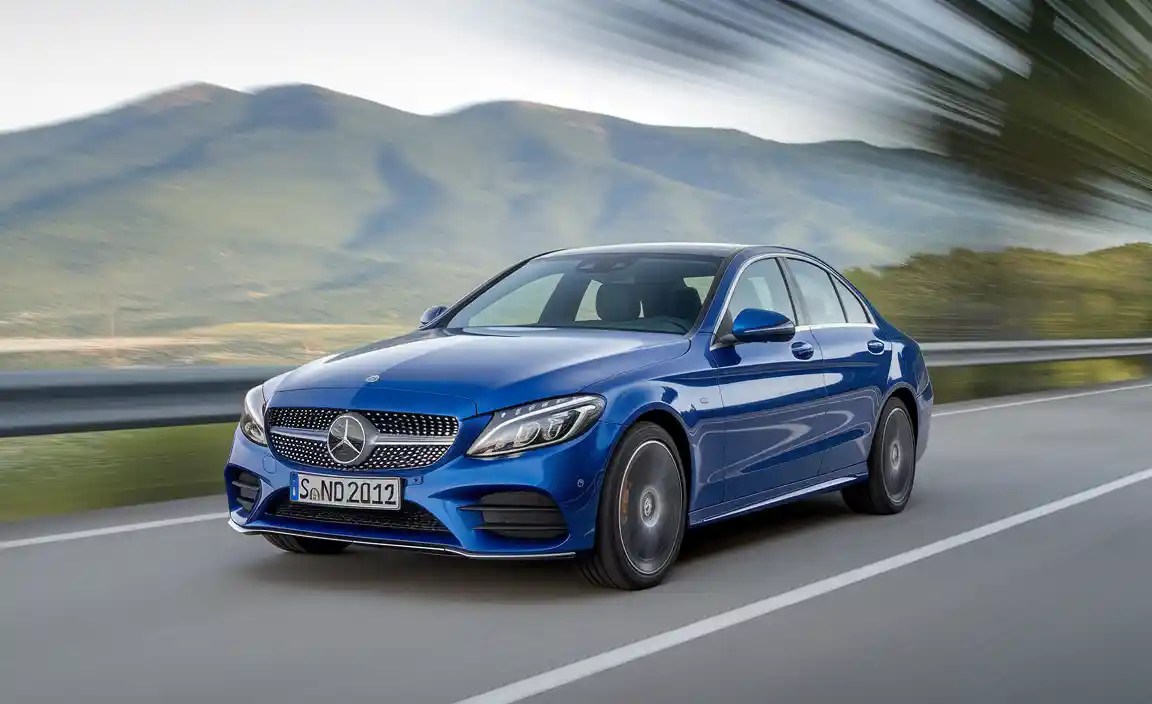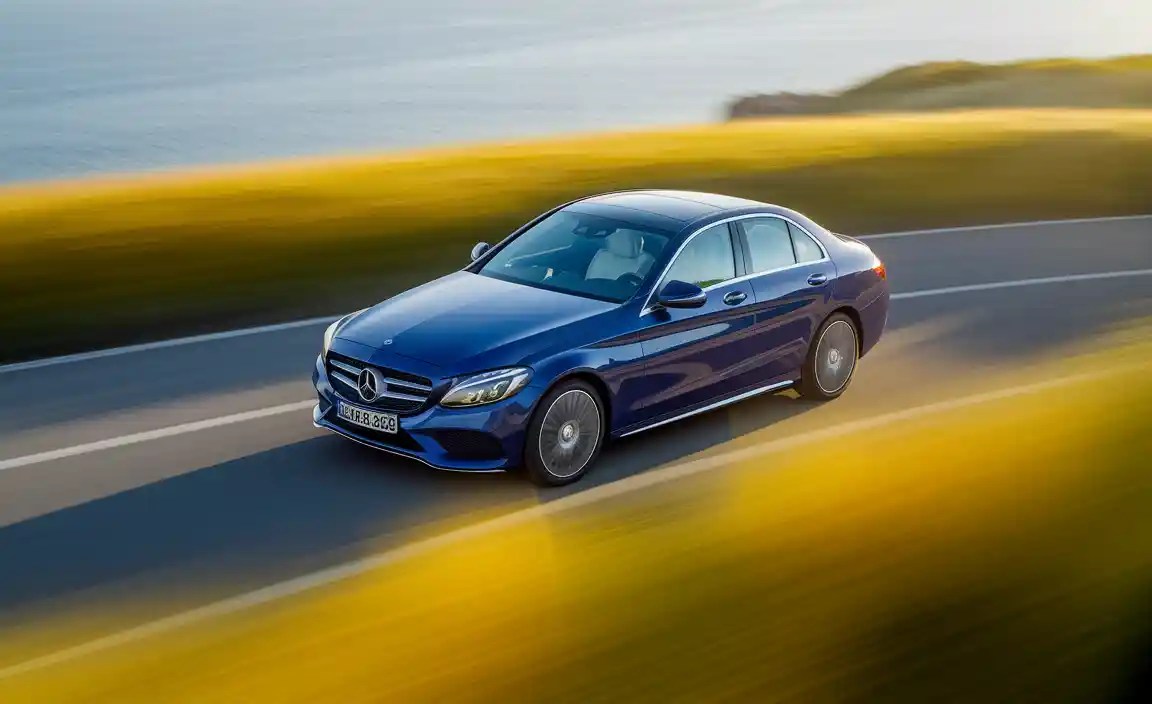Mercedes-Benz C Class Comfort Mode: Effortless Luxury
The C-Class Comfort Mode (often labeled ‘C’) on your Mercedes-Benz is designed to maximize driver and passenger relaxation. It prioritizes smooth acceleration, gentle gear shifts, and a more forgiving suspension for an exceptionally comfortable and serene driving experience, making everyday journeys feel like a luxurious escape.
Welcome to the world of effortless luxury, where your Mercedes-Benz C-Class transforms everyday driving into an experience of ultimate comfort. For many owners, the array of drive modes can seem a bit mysterious. Today, we’re focusing on one of the most accessible yet profoundly impactful: Comfort Mode. This setting is your gateway to a smoother, more relaxed ride, turning your commute or weekend cruise into a sanctuary of calm.
If you’ve ever wondered how to unlock that signature Mercedes-Benz plushness, you’re in the right place. We’ll demystify the C-Class Comfort Mode, explaining exactly what it does and how you can best utilize it for a truly serene driving experience. Get ready to rediscover the joy of serene motion.

Understanding Mercedes-Benz Drive Modes
Mercedes-Benz vehicles are celebrated for their engineering precision and customizable driving dynamics. Central to this is the DRIVE SELECT system, which allows you to tailor your car’s performance and feel to your preferences, the road conditions, or your mood.

These modes go beyond simply adjusting engine responsiveness; they influence up to 10 different vehicle systems, including the transmission, steering, suspension (if equipped with AIRMATIC), and climate control. This comprehensive approach ensures that each mode offers a distinct and meaningful driving experience.
The Role of DRIVE SELECT
The DRIVE SELECT system acts as the central command for your C-Class’s driving characteristics. By selecting different programs, you’re not just changing how the engine behaves; you’re fundamentally altering the car’s personality. This allows for incredible versatility, from a sportier, more engaging drive to the supremely comfortable and relaxed experience that Comfort Mode offers.
- Individual: Allows you to customize settings for engine, transmission, suspension, steering, and more.
- Sport / Sport+: Enhances engine and transmission response, sharpens steering, and firms up the suspension for a dynamic feel.
- Comfort: Prioritizes a smooth, relaxed ride with gentle responses.
- Eco: Optimizes for maximum fuel efficiency by reducing throttle response and modifying transmission shift points.
- Slippery: Designed for low-grip conditions (ice, snow, heavy rain) with a gentler throttle and earlier gear shifts.
What is C-Class Comfort Mode?
When you select “C” for Comfort on your Mercedes-Benz C-Class, you’re engaging a sophisticated system designed to deliver an exceptionally smooth and relaxed driving experience. It’s the default mode for a reason – it’s engineered to absorb imperfections in the road, minimize cabin noise, and make every journey feel effortless. Think of it as your personal oasis on wheels, smoothing out the bumps and calming the hustle of daily driving. This mode is perfect for long commutes, navigating city traffic, or simply when you desire a more tranquil and luxurious feeling behind the wheel.
How Comfort Mode Affects Your C-Class
Comfort Mode fine-tunes several key aspects of your C-Class to achieve its signature serene ride:
- Engine and Throttle Response: The accelerator pedal becomes less sensitive. This means that gentle inputs translate into smooth, gradual increases in speed, avoiding any sudden surges. It’s designed to prevent abrupt acceleration, contributing to a more fluid drive.
- Transmission Shift Points: Automatic transmissions in Comfort Mode prioritize higher gears more quickly and at lower engine speeds. This reduces engine noise and vibration, making for a more quiet and relaxed cabin environment. Shifts are also calibrated to be as smooth and imperceptible as possible.
- Steering Feel: The steering system is typically calibrated for reduced resistance. This makes turning the wheel easier and requires less effort, which is particularly beneficial during low-speed maneuvers like parking or navigating tight city streets.
- Suspension (if equipped with AIRMATIC or Adaptive Damping): If your C-Class has an adjustable suspension system, Comfort Mode will select the softest damping setting. This allows the suspension to absorb road imperfections more effectively, gliding over bumps and undulations for a significantly smoother ride quality.
- Climate Control: In some models, Comfort Mode can even influence the climate control system, potentially optimizing fan speed and vent direction for a more consistent and gentle airflow.
The overall goal of Comfort Mode is to reduce driver workload and enhance passenger comfort. It creates a buffered, serene connection between you and the road.
Activating C-Class Comfort Mode: A Simple Guide
Activating Comfort Mode in your C-Class is refreshingly straightforward, ensuring that you can switch to this luxurious setting with minimal fuss. Most modern C-Class models utilize a central control interface, either through the infotainment screen or physical buttons. Here’s the general process:

Step-by-Step Activation
- Ensure Your Engine is Running: With the engine on, you have access to all driving modes.
- Locate the DRIVE SELECT Control: This is typically found in one of a few places:
- Center Console Button: Many C-Class models have a dedicated button on the center console, often labeled “DRIVE SELECT” or featuring an icon with different driving modes around a central selection wheel or button.
- Infotainment Screen: Navigate through the vehicle’s main infotainment display. Look for a menu option related to “Vehicle,” “Driving,” or “DRIVE MODE.”
- Steering Wheel Controls: Some newer models might allow mode selection via buttons on the steering wheel, often integrated into the touch controls or scroll wheels.
- Select “C” for Comfort:
- If using a physical button, you might cycle through modes until “C” is illuminated or displayed.
- If using the infotainment screen, tap on the “Comfort” option within the driving mode menu.
- Confirm the Selection: Your instrument cluster or the infotainment screen will display an indication that “Comfort Mode” or “C” has been activated. You should immediately notice subtle changes in the car’s behavior.
Visual Confirmation
Once selected, you’ll typically see a clear visual indicator on your driver’s display or the central COMAND/NTG system screen. This might be the letter “C” appearing next to the gear selector, a specific icon representing Comfort Mode, or a text confirmation like “DRIVE MODE: COMFORT”. This visual cue ensures you know the system is engaged.
When to Use Comfort Mode
Comfort Mode is incredibly versatile. While its name suggests its primary purpose, it’s beneficial in a variety of driving scenarios. Understanding when to leverage its advantages can significantly enhance your driving experience and the overall appeal of your C-Class.
Ideal Scenarios for Comfort Mode
- Daily Commutes: Beat the stress of rush hour with a smoother, more forgiving drive. Comfort Mode makes stop-and-go traffic far less taxing.
- Long Highway Journeys: Reduce fatigue on extended drives. The relaxed throttle and smooth shifts mean less constant micro-adjustments, leading to a more restful experience.
- Navigating Poor Road Surfaces: Battered city streets, uneven rural roads, or areas with construction? Comfort Mode’s softer suspension (if applicable) will absorb shocks much better than sportier settings.
- Carrying Passengers: Especially if you have elderly passengers, children, or anyone prone to motion sickness, Comfort Mode provides the smoothest, most stable ride.
- Relaxed Driving: Sometimes, you just want to enjoy the journey at a more leisurely pace, appreciating the quiet, refined cabin of your C-Class without any urgency.
- First-Time Mercedes-Benz Drivers: If you’re new to the brand or a particular C-Class model, Comfort Mode is an excellent starting point to get acquainted with the car’s inherent luxury and refinement.
When to Consider Other Modes
While Comfort Mode is fantastic for serenity, it’s not always the optimal choice. For a more engaging, sporty driving experience, you might prefer Sport or Sport+ Mode. If maximizing fuel economy is your priority, Eco Mode is the way to go. For challenging low-traction conditions like snow or ice, Slippery Mode provides the necessary safety and stability. Understanding these distinctions helps you harness the full potential of your C-Class’s adaptive capabilities.
The Technology Behind the Comfort
The seamless experience of Comfort Mode isn’t just about soft settings; it’s underpinned by advanced Mercedes-Benz engineering. The brand consistently invests in technology to deliver the pinnacle of automotive comfort, and the C-Class is a prime example of this commitment.

Key Technological Elements
- Adaptive Damping System (ADS): Many C-Class models are equipped with ADS, which actively adjusts the shock absorber stiffness in real-time based on road conditions and driving inputs. In Comfort Mode, it biases towards a softer, more compliant setting. This system is crucial for balancing ride comfort with stable handling. You can learn more about adaptive suspension systems from resources like Car and Driver.
- AIRMATIC Air Suspension: Higher-end C-Class variants or optional packages might include AIRMATIC air suspension. This replaces traditional springs with adjustable air springs, offering unparalleled ride quality. Comfort Mode leverages AIRMATIC to its fullest, providing a cloud-like ride that isolates occupants from road imperfections.
- Agile Drivetrain Management: The sophisticated engine and transmission control units work in concert. In Comfort Mode, they precisely manage throttle mapping and shift logic to ensure smooth power delivery and seamless gear changes, avoiding any jerky transitions.
- Electromechanical Power Steering: The steering system is designed to provide variable assistance. Comfort Mode reduces the effort required for steering, making maneuverability effortless, especially at lower speeds.
These integrated systems work harmoniously to deliver the signature Mercedes-Benz “magic carpet” ride that Comfort Mode exemplifies.
C-Class Comfort Mode vs. Other Modes
To truly appreciate Comfort Mode, it’s helpful to compare it with other commonly available drive modes in the C-Class. This comparison highlights the distinct personality each mode imparts to the vehicle.
| Drive Mode | Primary Focus | Engine/Throttle Response | Transmission Shifts | Steering Feel | Suspension (Adaptive Systems) |
|---|---|---|---|---|---|
| Comfort (C) | Maximum Ride Smoothness & Relaxation | Gentle, gradual acceleration; less sensitive pedal input. | Prioritizes higher gears for lower RPMs; smooth, imperceptible shifts. | Lighter, easier steering; reduced effort. | Softer damping, favors absorbing bumps for plushness. |
| Sport (S) | Engaging, Dynamic Performance | Sharper, more immediate throttle response; more sensitive pedal. | Holds gears longer; quicker, more noticeable shifts; higher RPM range. | Firmer, more direct steering feel; increased feedback. | Firmer damping, reduced body roll; responsive to dynamic driving. |
| Eco (E) | Fuel Efficiency Optimization | Reduced throttle response; aims to minimize fuel consumption. | Earlier upshifts to lower RPMs; smoother, more economical shifts. | Can be lighter, similar to Comfort, to reduce driver effort. | Typically defaults to a Comfort-like or slightly firmer setting, depending on model. |
| Slippery (Slippery) | Low-Grip Condition Stability | Muted throttle response; designed to prevent wheel spin. | Earlier and gentler shifts; avoids aggressive acceleration. | May be lighter, prioritizing ease of control. | Often defaults to a Comfort-like setting for stability. |
This table illustrates how each mode systematically tunes the vehicle’s characteristics. Comfort Mode stands out for its dedication to reducing all forms of driver input effort and road disturbance.
The “S” vs. “C” Transmission Setting Nuance
It’s important to note that some Mercedes-Benz models, particularly older ones or those with specific transmission types, might display “S” or “C” directly on the gear selector itself. This typically refers to the transmission’s shift program rather than the full DRIVE SELECT mode. In this context:
- “C” (Comfort): The transmission will shift up earlier and hold gears less to keep revs low and ensure smoothness.
- “S” (Sport): The transmission will hold gears longer, shift at higher RPMs, and generally feel more responsive, mirroring the engine characteristics of the DRIVE SELECT Sport mode.
On newer models with comprehensive DRIVE SELECT, the “C” in the driving mode menu refers to the full Comfort experience, encompassing more than just the transmission.
Maximizing Your Comfort Mode Experience
While Comfort Mode is designed to be intuitive, a few tips can help you get the most out of its luxurious capabilities and ensure it remains in its prime condition.

Best Practices and Maintenance Tips
- Regular Tire Pressure Checks: Properly inflated tires are crucial for ride comfort. Under-inflated tires can lead to a softer, less controlled ride, while over-inflated tires can make the ride feel harsher. Refer to your driver’s side doorjamb sticker or owner’s manual for the correct tire pressures. You can find general guidance on tire maintenance from the National Highway Traffic Safety Administration (NHTSA).
- Wheel and Tire Alignment: Misaligned wheels can cause uneven tire wear and affect steering feel, potentially counteracting the benefits of Comfort Mode. Ensure your alignment is checked periodically, especially after hitting a significant pothole.
- Suspension System Inspection: If your C-Class has adaptive damping or air suspension, regular checks by a qualified technician are essential. Leaks in air suspension or worn dampers can degrade ride quality significantly.
- Consider Your Tires: The type of tires fitted to your C-Class can have a substantial impact on comfort. Touring or Grand Touring tires are generally designed for quieter rides and better shock absorption compared to performance or summer tires.
- Keep It Clean: While not directly related to the mode itself, a clean cabin contributes to the overall feeling of luxury and well-being that Comfort Mode aims to provide.
Personalization through Individual Mode
For those who find Comfort Mode almost perfect but want minor tweaks, the “Individual” mode in DRIVE SELECT offers a fantastic solution. You can engage Individual mode and then manually set the engine, transmission, and steering to “Comfort” while potentially adjusting the suspension to a slightly firmer setting if desired, or vice versa. This allows for a truly personalized luxury experience.
Frequently Asked Questions (FAQ)
Q1: What does the “C” stand for in C-Class Comfort Mode?
A: In this context, “C” stands for “Comfort,” indicating the drive mode is optimized for a relaxed and smooth driving experience, prioritizing ride quality and gentle responses.
Q2: Is Comfort Mode bad for my car’s engine or transmission?
A: No, Comfort Mode is not detrimental to your engine or transmission. It simply changes how they are programmed to operate. It can even be less stressful on components due to smoother engagement and less aggressive operation compared to Sport Mode.
Q3: Will Comfort Mode improve my fuel economy?
A: Comfort Mode is not primarily designed for fuel economy. The “Eco” mode is specifically tuned for maximum efficiency. While Comfort Mode’s smoother acceleration can be more fuel-efficient than aggressive driving in Sport Mode, Eco Mode offers superior fuel savings.
Q4: Can I feel a difference immediately when switching to Comfort Mode?
A: Yes, you should notice a difference almost immediately. The steering will likely feel lighter, the throttle response more subdued, and engine revs may drop as the transmission shifts to a higher gear if you are already in motion. If equipped with adaptive suspension, you’ll feel the ride soften.
Q5: How do I know if my C-Class has an adaptive suspension system?
A: You can check your original vehicle window sticker or the owner’s manual. If your car has an adjustable suspension, it will likely be listed as “AIRMATIC Air Suspension” or “Adaptive Damping System (ADS)” or similar. Often, the DRIVE SELECT menu on the infotainment screen will also show suspension adjustment options.
Q6: Is Comfort Mode good for driving in heavy rain or snow?
A: For heavy rain or snow, the “Slippery” mode is generally recommended. It provides optimized traction control and throttle mapping for low-grip conditions. While Comfort Mode is smoother than Sport, Slippery mode is specifically calibrated for safety in adverse weather.






